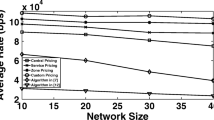Abstract
In this paper, we address joint spectrum allocation and pricing problem in heterogeneous wireless access networks. In contrast to traditional static spectrum allocation approach, we model the spectrum as a market commodity, dynamically arbitrated by a regulatory agent with the aim of maximizing the social welfare. This is of particular importance with the dominance of wireless technologies in access networks and the sharp increase in the number of overlapping wireless technologies and networks. We designed a novel Walrasian mechanism called economic resource allocation and pricing based on a three-stage game model capable of considering multiple networks and clients with individual attributes and preferences. In the first stage, competition among networks for spectrum allocation is handled where the regulatory evaluates the social welfare and takes corrective action. In the bottom two stages, the complex interactions between clients and networks result in bitrate allocations and service pricings. The equilibrium condition is analyzed using the Walrasian market model which is argued to be the Nash equilibrium of the proposed game. The system behavior is analyzed through extensive simulations. The results confirm the effectiveness of the proposed mechanisms in moving the system towards maximal social welfare.









Similar content being viewed by others
References
Akyildiz, I. F., Lee, W.-Y., Vuran, M. C., & Mohanty, S. (2008). A survey on spectrum management in cognitive radio networks. IEEE Communications Magazine,46(4), 1.
Niyato, D., & Hossain, E. (2008). Competitive pricing in heterogeneous wireless access networks: Issues and approaches. IEEE Network,22(6), 4–11.
Chen, Q.-B., Zhou, W.-G., Chai, R., & Tang, L. (2011). Game-theoretic approach for pricing strategy and network selection in heterogeneous wireless networks. IET Communications,5(5), 676–682.
Wu, Q., Du, Z., Yang, P., Yao, Y.-D., & Wang, J. (2016). Traffic-aware online network selection in heterogeneous wireless networks. IEEE Transactions on Vehicular Technology,65(1), 381–397.
Wang, W., Liang, B., & Li, B. (2014). Designing truthful spectrum double auctions with local markets. IEEE Transactions on Mobile Computing,13(1), 75–88.
Zhu, Y., Li, B., & Li, Z. (2012, March 25). Truthful spectrum auction design for secondary networks. In INFOCOM, 2012 proceedings IEEE (pp. 873–881).
Nguyen, T., Zhou, H., Berry, R. A., Honig, M. L. & Vohra, R. (2011). The impact of additional unlicensed spectrum on wireless services competition. In 2011 IEEE international symposium on dynamic spectrum access networks (DySPAN) (pp. 146–155). IEEE.
Chen, Y., Duan, L., Huang, J., & Zhang, Q. (2015). Balancing income and user utility in spectrum allocation. IEEE Transactions on Mobile Computing,14(12), 2460–2473.
Cao, J., Wu, J., & Yang, W. (2017). Spectrum allocation strategy for heterogeneous wireless service based on bidding game. KSII Transactions on Internet and Information Systems (TIIS),11(3), 1336–1356.
Haghighatdoost, V., & Khorsandi, S. (2019). Game theoretic spectrum allocation for competing wireless access technologies to maximize the social welfare. Wireless Networks,25(6), 3557–3577.
Jehle, G. A., & Reny, P. J. (2011). Advanced microeconomic theory. London: Prentice-Hall International.
Bari, F., & Leung, V. (2007). Multi-attribute network selection by iterative TOPSIS for heterogeneous wireless access. In 2007 4th IEEE consumer communications and networking conference (pp. 808–812). IEEE.
Haghighatdoost, V., & Khorsandi, S. (2018). Numerical approach to find the Walrasian equilibrium using stability analysis of feedback controller arxiv.org.
Matinkhah, S. M., & Khorsandi, S. (2012, November 6). Using data envelopment analysis for base station selection in heterogeneous wireless access networks. In 2012 Sixth international symposium on telecommunications (IST) (pp. 766–770).
Matinkhah, S. M., Khorsandi, S., & Yarahmadian, S. (2017). A load balancing system for autonomous connection management in heterogeneous wireless networks. Computer Communications,97, 111–119.
Sallent, O., Pérez-Romero, J., Agusti, R., Giupponi, L., Kloeck, C., Martoyo, I., Klett, S., & Luo, J. (2006). Resource auctioning mechanisms in heterogeneous wireless access networks. In 2006 IEEE 63rd vehicular technology conference (Vol. 1, pp. 52–56). IEEE.
Haghighatdoost, V., & Khorsandi, S. (2017). Mechanism design for pricing and bandwidth allocation in heterogeneous wireless networks to maximize the social welfare. In 2017 9th international conference on information and knowledge technology (IKT) (pp. 129–140). IEEE.
Author information
Authors and Affiliations
Corresponding author
Additional information
Publisher's Note
Springer Nature remains neutral with regard to jurisdictional claims in published maps and institutional affiliations.
Rights and permissions
About this article
Cite this article
Haghighatdoost, V., Khorsandi, S. A new Walrasian mechanism design for optimal pricing and resource allocation in heterogeneous wireless access networks. Wireless Netw 26, 3053–3068 (2020). https://doi.org/10.1007/s11276-020-02258-7
Published:
Issue Date:
DOI: https://doi.org/10.1007/s11276-020-02258-7




